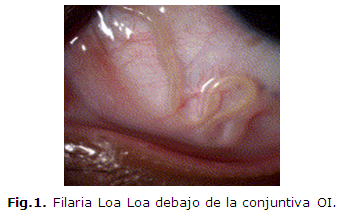Filariasis
Palabras clave:
Filariasis/diagnóstico/parasitología/epidemiología, Nematodos/parasitología.Resumen
Introducción: la filariasis es una parasitosis importada producida por nemátodos (gusanos redondos) hemáticos de la familia Filariidae. Existen alrededor de 200 tipos de filarias parásitas pero solo unas pocas parasitan al hombre.Caso clínico: se presentó el caso de un paciente, extranjero, masculino, de 30 años de edad, procedente de Guinea, que acudió a la consulta de Oftalmología del Cuerpo de Guardia del Hospital General Docente "Abel Santamaría Cuadrado" de Pinar del Río, con sensación de cuerpo extraño en ambos ojos y sin otra sintomatología. Después de un examen oftalmológico minucioso se hace el diagnóstico presuntivo de una filariasis ocular.
Conclusiones: la filariasis es una de las enfermedades exóticas en Cuba. Se hace necesario elevar la vigilancia epidemiológica de dichas enfermedades, debido a la recurrencia de las visitas de personas procedentes de áreas endémicas. De vital importancia resulta la adecuada evaluación de estos pacientes, para lograr la identificación temprana y aplicar métodos oportunos de tratamiento.
Descargas
Citas
1. Gil-Setas A, Pérez Salazar M, Navascués A, Rodríguez Eleta F, Cebamanos JA, Rubio MT. Confección por dos filarias (Loa loa y Mansonella perstans) en una paciente proveniente de Guinea. An Sist Sanit Navar. 2010; 33 (2): 227-31. Disponible en: http://scielo.isciii.es/scielo.php?pid=S1137-66272010000300012&script=sci_arttext
2. Bourée P. Les Filarioses du Gabón. Gabón Magazine. Fevrier 2010; 10: p. 24-30.
3. Simonsen PE, Onapa AW, Asio SM. Mansonella perstans filariasis in Africa. Acta Trop. 2011;120(S1):109-20. Disponible en: http://www.sciencedirect.com/science/article/pii/S0001706X1000032X
4. Akue JP, Nkoghe D, Padilla C, Moussavou G, Moukana H, Mbou RA, et al. Epidemiology of concomitant infection due to Loa loa and Mansonella perstans in Gabon. PLo S Negl Trop Dis. 2011; 5(10): e1329. Disponible en: http://www.plosntds.org/article/info%3Adoi%2F10.1371%2Fjournal.pntd.0001329
5. Passos RM, BarbosaCP, Almeida J de S, Ogawa GM, Camargo LM. Subconjuntival Loa loa worm:first case report in Brazil . Arq Bras Oftalmol. 2012; 75: 67-70: Disponible en: http://www.ncbi.nlm.nih.gov/pubmed/22552423
6. Baucom HB, Berry-Cabán CS, Carlton DK, Beaman LA (2013) Ocular Loiasis in a US Soldier. Trop Med Surg 1: 121. doi:10.4172/ 2329-9088.1000121. Disponible en: http://esciencecentral.org/journals/ocular-loiasis-in-a-us-soldier-2329-9088.1000121.php?aid=14835
7. Vargas-Herrera J, Arróspide-Velasco N, Gutierrez-González S, Celis-Salinas JC, Huamaní-Solano D. Reporte de cuatro casos clínicos de filariasis en Alto Nanay, Loreto. Rev. perú. med. exp. salud publica, Lima, v. 30, n. 3, jul. 2013. Disponible en http://www.scielo.org.pe/scielo.php?script=sci_arttext&pid=S1726-46342013000300022&lng=es&nrm=iso. accedido en 12 nov. 2014
8. Omolase CO, Adedosu AN, Omolase BO, Sotiloye OA, Omolade EO, et al. Ocular Loiasis in a Nigerian Female Adult. Int J Ophthalmic Pathol. 2013; 2:4. doi:10.4172/2324-8599.1000124.
9. Gopinath TN, Lakshmi KP, Shaji PC, Rajalakshmi PC. Periorbital dirofilariasis—Clinical and imaging findings: Live worm on ultrasound. Indian J Ophthalmol. 2013 June; 61(6): 298-300. Disponible en: http://www.ncbi.nlm.nih.gov/pmc/articles/PMC3744785/
10. Wiwanitkit S, Wiwanitkit V. Periorbital dirofilariasis. Indian J Ophthalmol. 2014 January; 62(1): 94.

Publicado
Cómo citar
Número
Sección
Licencia
Aquellos autores/as que tengan publicaciones con esta revista, aceptan los términos siguientes:- Los autores/as conservarán sus derechos de autor y garantizarán a la revista el derecho de primera publicación de su obra, el cuál estará simultáneamente sujeto a la Licencia de reconocimiento de Creative Commons que permite a terceros compartir la obra siempre que se indique su autor y su primera publicación esta revista.
- Los autores/as podrán adoptar otros acuerdos de licencia no exclusiva de distribución de la versión de la obra publicada (p. ej.: depositarla en un archivo telemático institucional o publicarla en un volumen monográfico) siempre que se indique la publicación inicial en esta revista.
- Se permite y recomienda a los autores/as difundir su obra a través de Internet (p. ej.: en archivos telemáticos institucionales o en su página web) antes y durante el proceso de envío, lo cual puede producir intercambios interesantes y aumentar las citas de la obra publicada. (Véase El efecto del acceso abierto).


